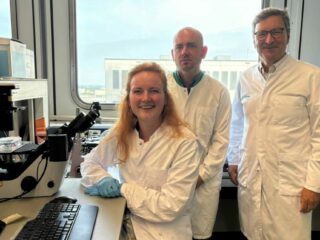The newly identified DNA repair protein has the name STK19. This protein wasn’t entirely unknown to scientists, explains professor Jurgen Marteijn from Erasmus MC. “Previous studies had suggested that this protein might be linked to DNA repair. There wasn’t conclusive evidence yet, but we thought: if there’s so much smoke, there must be fire.” Indeed, that proved to be the case, as the researchers describe in the scientific journal Molecular Cell.
Tens of thousands of damages per day
DNA damage is a part of life. From sunlight and smoking to our own metabolism, our genetic material is constantly being damaged. This adds up to tens of thousands of damages per day in every cell. DNA damage is problematic for the cell because it can interfere with the process of reading genes.
If this transcription process fails, the cell cannot produce the proteins needed for proper functioning, potentially leading to aging-related diseases. Therefore, the cell is constantly busy detecting and repairing DNA damage. To do this, it uses various repair proteins that work together in a complex molecular machine.
The researchers found that STK19 acts like molecular glue. As a “big connector” it holds together various proteins that form the DNA repair complex. Additionally, it plays another crucial role in this repair pathway: it recruits other proteins that ultimately cut out the damaged part of the DNA. Together, this ensures that gene transcription can continue smoothly, even in the case of DNA damage.
Fun puzzle to solve
‘A very essential player indeed’, concludes Anisha Ramadhin, a PhD student at Erasmus MC. She conducted several experiments with cells lacking STK19 and observed that transcription disrupting DNA damage was not properly repaired. ‘This shows how crucial this protein is for DNA repair.’ Ramadhin is proud of the discovery: ‘This is what I find fulfilling: solving things that weren’t known yet, creating hypotheses, devising sub-questions, and doing increasingly complex experiments at each step. This was a fun puzzle to solve.’
More knowledge about how the DNA repair reaction works is important, Marteijn emphasizes. ‘A well-functioning repair machine protects us against aging. Conversely, problems with DNA repair lead to aging diseases. We see this at an extreme level in patients with the rare Cockayne syndrome, but DNA damage also accumulates in healthy individuals over a lifetime.’
Cryogenic electron microscopy
For this research, the Erasmus MC team closely collaborated with Titia Sixma’s group from the Netherlands Cancer Institute (NKI), experts in protein analysis. Postdoctoral researcher Shun-Hsiao Lee from NKI observed that the protein STK19 also functions as an adhesive in vitro. Using cryogenic electron microscopy, or cryo-EM, the DNA repair complex was visualized in three dimensions (see video below). This allowed the researchers to see how STK19 binds within the complex, gaining a better understanding of the protein’s function.
Both Sixma and Marteijn are also affiliated with the Oncode Institute.



